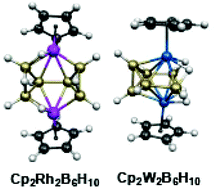Dimetallaborane analogues of the octaboranes of the type Cp2M2B6H10: structural variations with changes in the skeletal electron count†
Abstract
The structures and energetics of the complete series of hydrogen-rich dimetallaboranes Cp2M2B6H10 and Cp*2M2B6H10 (Cp = η5-C5H5; Cp* = η5-Me5C5; M = Pd, Pt; Rh, Ir; Ru, Os; Re; Mo, W; Ta), including the experimentally known Cp*2Rh2B6H10 and Cp*2W2B6H10 (Cp* = η5-Me5C5), have been investigated by density functional theory. The lowest energy structures of the hyperelectronic Cp2M2B6H10 (M = Pd, Pt; Rh, Ir) systems have central M2B6 frameworks with a hexagonal open face similar to the B8 networks in arachno-B8H14 and nido-B8H12. The two lowest energy structures for Cp2Rh2B6H10 and Cp*2Rh2B6H10, lying within 1 kcal mol−1 of energy, differ only in the locations of the bridging hydrogen atoms around the hexagonal hole consistent with the experimentally observed fluxionality of the hydrogen atoms in Cp*2Rh2B6H10. Most of the lowest energy Cp2M2B6H10 (M = Ru, Os) structures also have a central M2B6 framework similar to B8H12, typically with such additional features as an additional metal–metal bond or a formal metal–metal double bond. A common motif for the low-energy structures of the hypoelectronic Cp2M2B6H10 (M = Re; Mo, W; Ta) systems, including the experimentally known Cp*2W2B6H10, is a central M2B4 octahedron with its two M2B faces capped by the remaining boron atoms and with four M–B edges bridged by hydrogen atoms. Such structures can also be considered as oblatonido structures derived from the experimentally known 9-vertex oblatocloso Cp*2Re2B7H7 structure by removal of the unique degree 4 vertex atom.


 Please wait while we load your content...
Please wait while we load your content...